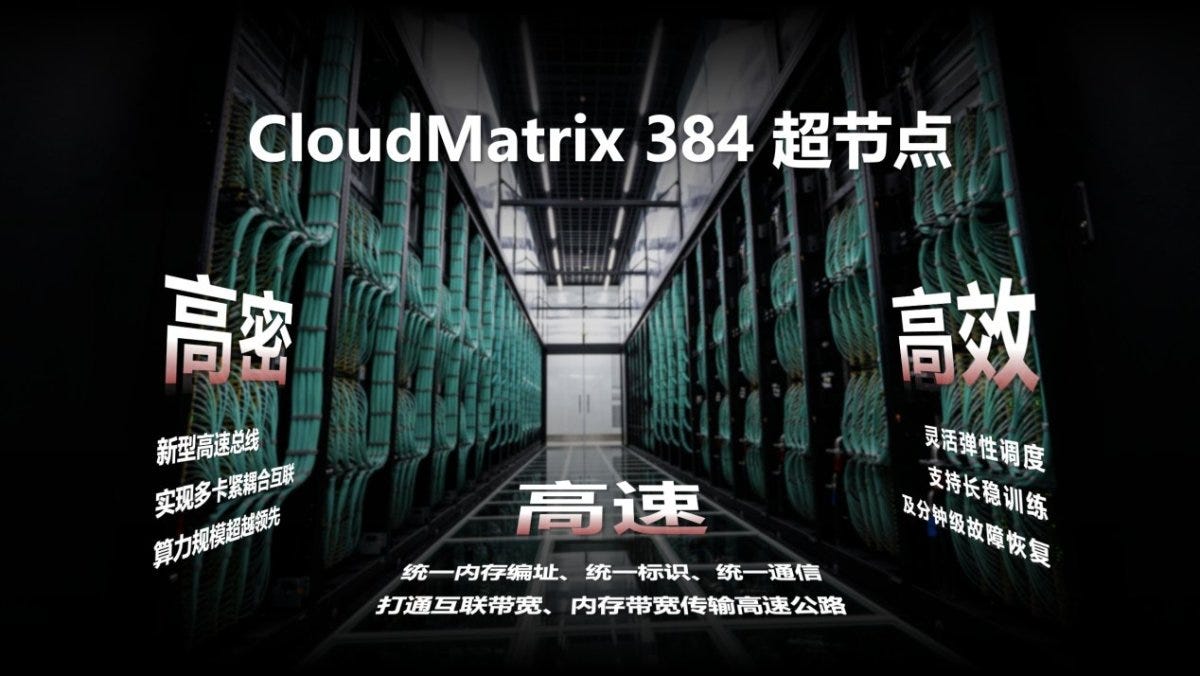Dylan Patel and Doug O’Laughlin of SemiAnalysis explore Huawei new rack and its broader strategy of leveraging structural advantages to resist, circumvent, and nullify export controls — as well as how the U.S. government should respond.
We also get into chip tariff policy. Semiconductors are exempt from Trump’s reciprocal tariffs for now, but the administration has signaled that chip-specific tariffs are coming soon. Dylan gives his pitch for how tariffs could be used to save American manufacturing, move high-tech supply chains out of China, and even reduce the national debt!
Listen now on iTunes, Spotify, or your favorite podcast app.
Huawei’s Edge and What to Do About It
Jordan Schneider: Dylan, tell us about what's going on with Huawei.
Dylan Patel: Huawei has the Ascend 910B and 910C. It's the same chip silicon-wise, but we've been banging on the drums about this for years now. Systems matter more than individual chips for AI workloads. When we look at Nvidia, one of their three core competencies is networking and systems, another is the chip itself. These are almost equivalent-level components.
What Huawei has done is taken a 7-nanometer chip that is mostly produced at TSMC, some at SMIC, but mostly at TSMC, and put it into a system that consumes more power with more chips, but they've networked it together in such a way — they've cooled it, they've done all the networking — where the performance is actually going to be better than Nvidia's GB200 NVL72 rack. This is the new product that Nvidia is shipping right now in mass production. It's what everyone wants. To be clear, it's really good.
Nvidia's solution is one rack that consumes 140 kilowatts. Huawei has made a system that consists of 16 racks of compute connected all together through optical fiber, using approximately 6,000 optical transceivers connecting the Ascends together. Yes, it consumes 550kW versus 140kW for Nvidia. This is a huge step up in power, but it also brings 2-3x the performance in memory and FLOPS.
When we talk about software to utilize it, understand that Huawei's software is better than AMD's. They support JAX, Python, PyTorch as first-class citizens, and support VLMs. There's a lot of software support that they've already built out publicly. Huawei's engineers are exceptional — their software engineers are arguably just as good as Nvidia's. You can see this in all the products they've built over the years.
Huawei has turned what is effectively a big handicap on chips into a workable solution. They'll use 2-3x the power to achieve 2-3x the performance, but that's acceptable because China can build power infrastructure. The US doesn't build power infrastructure as readily.
This is critical to consider — Huawei continues to receive HBM through this Faraday-CoAsia loophole:
Samsung has come to the rescue, having been the number one supplier of HBM to China through which Huawei has been able to stockpile a total of 13 million HBM stacks which can be used for 1.6 million Ascend 910C packages before any HBM bans.
Furthermore, this banned HBM is still being re-exported to China. The HBM export ban is specifically for raw HBM packages. Chips with HBM can still be shipped as long as they don’t exceed the FLOPS regulations. CoAsia Electronics is the sole distributor of HBM for Samsung in Greater China and they have been shipping HBM2E that is to ASIC design service company Faraday who gets SPIL to “package” it alongside of a cheap 16nm logic die.
Faraday then ships this system in package to China, which is technically allowed, but Chinese companies can then recover the HBM by desoldering. We think they employ techniques to make it very easy for the HBM to be extracted from the package, like using very weak low-temperature solder bumps, so when we say it is “packaged,” we mean this in the loosest way possible.
They've stockpiled a significant amount because the US government telegraphed the bans on HBM for nine months instead of implementing them immediately.
They continue to receive wafers. Allegedly — I haven't been able to validate this personally — Huawei received over $500 million of wafers just for the Ascend alone last year. They could potentially still be receiving wafers from TSMC. Furthermore, as SMIC continues to improve their yields — even if they only reach a paltry 20% — they could produce millions of Ascend chips because we continue to sell leading-edge equipment to SMIC to produce wafers. We continue to sell leading-edge equipment to CXMT to produce wafers. Yes, there are some restrictions against them, but these restrictions have loopholes.
Given all these factors, Huawei will be able to ramp production unless the US government improves its strategy. They should have focused their attention on banning the equipment before addressing the H20. Now they're just taking revenue away from Nvidia while still allowing China to import advanced technology. ASML recently stated that China is buying a lot more high-end equipment than expected.
There are significant issues with the government's strategy. They're doing things backwards. Credit to them for banning the H20 — perhaps that was necessary — but they got the order of operations completely wrong, and many loopholes were left by the Biden administration.
The Trump administration now has the chance to be tough on China in ways the Biden administration claimed to be but wasn't fully committed to, though they haven't taken decisive action yet. We'll see if the Trump administration decides to be genuinely tough on China. Their rhetoric is strong but their actions have been weak so far. They recently laid off one of my favorite people in the NSC because Laura Loomer claimed he was a "deep state agent." This is not a joke — this is serious. There are many concerning decisions being made, and I want the administration to do better. I'm happy to advise them on what they need to do.
Doug O'Laughlin: This is not just ASML. All of the suppliers have been saying there's been incremental pull-ins on demand for semiconductor capital equipment specifically in China.
Dylan Patel: It's equipment, subsystems, and especially metrology equipment, which is barely controlled and completely a US industry. There are chemicals that could be used to cut off SMIC or the Huawei-associated fabs, but they won't do that.
Doug O'Laughlin: People don't fully appreciate that Huawei is vertically integrated. Huawei is dominating the Chinese domestic ecosystem. They steal NARA and AMEC tools as well. There's a tool they had that's identical to a DISCO tool we saw, and there's an identical KLA tool. The equipment manufacturer SiCarrier is also functionally an arm of Huawei.
Dylan Patel: Let's be clear about SiCarrier and Huawei. Huawei bought about $8 billion of equipment last year. They're simultaneously running wafers through their tool and imported tools side by side and calibrating their tool to improve. They're continuously getting better and better. It's amazing how well they're doing this.
Doug O'Laughlin: What's crazy is that Huawei and Microsoft have the same number of employees.
Dylan Patel: Pound for pound, Huawei is so much better than Microsoft.
Doug O'Laughlin: Microsoft does make a lot more money, to be clear. But Huawei is massive, and they're doing hardware, software, and multiple layers of hardware networking. What is Huawei not doing?
Dylan Patel: Huawei is even doing electric vehicles, which are fire. (YouTube review, but bilibili spocon is way more fun).
Doug O'Laughlin: Jensen Huang has said before: Huawei is “single most formidable technology company in China.”
Jordan Schneider: Can you explain the vertical integration and what SiCarrier is aiming to become?
Doug O'Laughlin: SiCarrier makes tools. They're like Applied Materials, ASML, and KLA. But Huawei and SMIC are heavily involved.
Dylan Patel: SiCarrier has already bought about $2.5 billion worth of equipment for an HBM fab that they're building for SMIC/Huawei. They’ve built leading-edge 7 nm and 5 nm fabbing tools. They have a new form of non-volatile memory which should beat DRAM in cost and NAND in performance. There's an advanced packaging Huawei fab. The US government doesn't consider any of that to be part of Huawei. But if you use basic logic, they're clearly Huawei.
Jordan Schneider: Anything else on Huawei?
Dylan Patel: It's important to recognize what they did on the networking side as well, which was really impressive. They built their own switches. They built their own NVLink equivalent, which is impressive on its own. But then on top of that, they built their own optical transceivers.
Every single optical transceiver that goes into a Google TPU pod is made in China by a Chinese company. Approximately 70% of optical transceivers that Nvidia uses are designed in China and shipped to all these servers. Most of them are built in China as well. There's a significant optical supply chain issue that America has that needs addressing immediately.
China has their own optical supply chain, and it's remarkable because they've become the first to productize this technology called LPO. Doug and I have been discussing this for exactly two years now. It essentially involves taking an optical transceiver and removing the most expensive chip while still making it work. It's cheaper, lower power, and technically lower latency. The challenge is that it's somewhat less reliable, but with good engineering, you can solve that problem. Huawei figured it out before anyone else.
Optimizing Tariffs
Jordan Schneider: What’s going on with our semiconductor tariff situation?
Dylan Patel: If they are intelligently designed, the semiconductor tariffs could do a lot of positive things. But they could also do a lot of negative things.
Jordan Schneider: How would you design semiconductor tariffs?
Dylan Patel: First, if you import a subcomponent into the US and then export it out of the country, you should be able to get a refund on the tariff you paid on that subcomponent. This shouldn't be limited to just semiconductors either — we should have a policy that you can get import credits for anything you export out of the country. That fixes a lot of the tariff issues. This is done by some countries, but not by America.
Second — and let's frame this as an electronics tariff, not just a semiconductor tariff — any sub-materials or subcomponents should be excluded from the tariff initially. Take consumables, for example. We don't make wafer sputter targets in America; everyone just imports them. It would be nice if we made some in America, but we don't want to increase costs for American factories that rely on those imports.
Instead, we should implement a phased-in tariff. If it takes two years to build a sputter target factory in America, we should announce that a tariff on sputter targets will go into effect in two and a half years. That way, no producers get obliterated. This needs to be communicated very clearly so that everyone knows it's coming. We should do this for as many subcomponents as possible.
Next, the tariffs on final assembled goods should be much higher than the tariffs on sub-components and sub-assemblies. We should impose heavy tariffs on iPhones even if it's politically unpopular. Instead of excluding them, iPhones should be hit with a 135% tariff if they're made in China or a 25% tariff if they're made in another country. But the sub-components, such as the display from South Korea, should either not be tariffed or be tariffed at a very low rate. That creates a waterfall effect where it becomes profitable to do the assembly in America or USMCA countries.
Finally, we should reclassify goods. Right now, motors and robotics are in the same classification. That means no one is going to manufacture robotics in America. Under the current policy, if you import a motor in order to make a robot for export, it's not considered a “substantial transformation,” and thus you can't get any exemptions. Whereas if you import a chip and then use it to make a computer or a PCB board, it's a substantial transformation.
We should definitely impose steep tariffs on China and not tariff other countries nearly as much, because many of these tariffs should work by moving supply chains out of China and into Vietnam, Indonesia, Malaysia, India, Mexico, Canada, as well as the U.S.
Jordan Schneider: Why should we want assembly to happen in America?
Dylan Patel: Assembly is actually not that labor-intensive anymore. When we talk about automation, we're never going to get automated factories in America if the factory doesn't exist in America in the first place. When they move the factory to America, they're going to automate it much more.We need assembly in places other than China. Specifically, we need assembly in America because the process becomes less labor-intensive and more capital-intensive over time, and America should not be at a deficit when it comes to capital intensity.
We can increase our tax base massively if we have all of the highly capital-intensive activities happen in America. We need to have that small set of skilled labor operating massively capital-intensive factories.
There shouldn't be a natural advantage for other countries versus America in these areas, but there is because we don't have any supply chains here. The main thing we need to do is import 100,000 Taiwanese citizens into America and build every fab in America. We need to import around 100,000 Korean people and build memory in America.
If you look at the labor cost of an Intel fab or a TSMC fab, it's minuscule. For a gigafab — a fab that makes over 100,000 wafers a month — there are only a handful of those in the world. Power costs just as much as the people, and power costs twice as much in Taiwan. For all intents and purposes, a fab should actually be cheaper in America. But we have supply chain issues with gas delivery, tool delivery, tool installations, and all these other things.
A hundred-billion-dollar fab has about 10,000 people working in it. That's nothing. It's not about the jobs — it's the fact that it's here in America and it's now contributing to the tax base. Fabs are an example of ridiculous capital intensity for very low labor. That labor is intelligent and very skilled, but we can just import them.
We should fix the trade deficit by having a larger talent deficit. These highly capital-intensive aspects of society are really something America should have, and we don't. We should be building $100 billion factories like TSMC is in America, eventually, hopefully.
The same should happen across all these supply chains. Now fabs are extreme, but assembly is going to get there. A lot of manufacturing is going to get there because robotics is really hitting its golden age. There's a lot that robotics and AI are going to do that makes things even more capital-intensive and even less labor-intensive.







